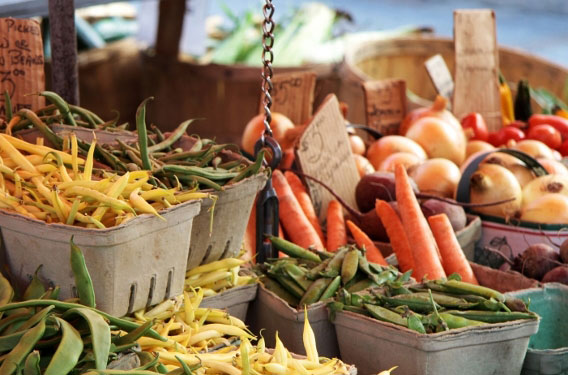Local Potential
Mapping the flow of foods to cities—and finding out if locavore is the way to go
By Julie Flaherty
Advocates of local food say buying food closer to the source is fresher, more nutritious and better for the environment than buying stuff that’s been trucked in over miles and miles. But even if we gave up bananas and pineapples, and strove to eat in a 100-mile radius, would there be enough food for everyone? Can all food be local?

“If you can’t produce everything, what should you choose to produce?” asks Christian Peters. Photo: iStock
In New York state, at least, the answer is no. That is where Christian Peters, an assistant professor at the Friedman School, has studied the potential of local food systems through the mapping of “foodsheds.”
Much like its namesake the watershed, a foodshed is a tool for understanding the flow of food in a food system. Peters collected data on the location of New York’s available farm land and its productivity; the location of population centers and the number of people living in or near them; and the land needed to feed people an adequate diet.
He found that it would take all of the state’s agricultural resources to meet just half of the total food needs of New York City alone. But there was good news for locavores, too. In places like Albany, Buffalo, Syracuse and Rochester people could meet nearly all of their food needs surprisingly close to home.
“That’s valuable information to help frame the debate” about local foods, Peters says. “If you can’t produce everything, what should you choose to produce?”
Peters, who joined the Friedman School this year in the Agriculture, Food and Environment Program, plans to apply his methodology to a larger area, such as the lower 48 states. He hopes his mapping method will help in the search for sustainable agriculture strategies in the face of growing food needs and diminishing resources.
Part of what makes his research unusual is that it looks at both farming and nutrition. “Food consumption and agricultural production are interdependent, and new tools are needed to understand how one influences the other,” he writes.
For a study published in 2007, for example, he looked at 42 different diets to determine which offered the most efficient use of farmland in New York state. The diet that fed the most people—about a third of the population—was a low-fat vegetarian diet.
But interestingly, when he looked at diets with higher amounts of fat—such as a vegetarian diet with plenty of oils and a diet with small amounts of meat or eggs—the omnivore diet was more efficient. Why? Because oil-producing crops like corn and soybean require high-quality acreage, while cows, sheep and goats can be raised on lower-grade hay and pasture lands, which might not otherwise be put to use.
That’s useful to know, even if Americans aren’t ready to radically change their diets. “There wasn’t a very good sense of what was possible,” Peters says.
Julie Flaherty can be reached at julie.flaherty@tufts.edu.


